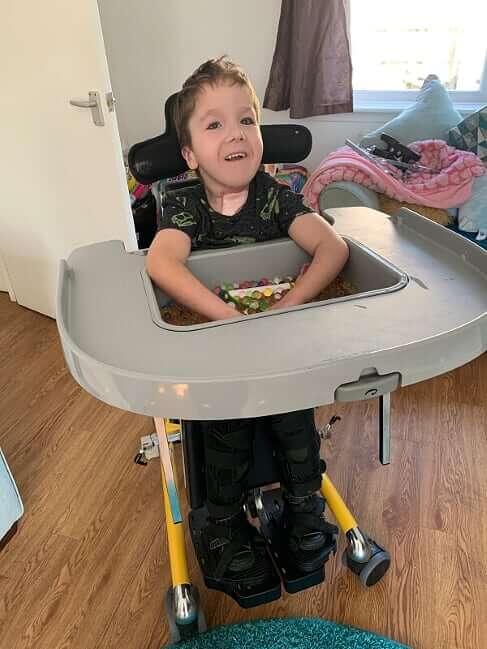10 Dry Messy Play Ideas for a Wheelchair User
Messy play is a brilliant opportunity for imaginative or pretend play or just to feel new textures and have lots of fun! The great thing about messy play is that it doesn’t matter how much movement or control our child has in their hands. Any child can access some form of messy play.
If our child dislikes feeling mucky and getting dirty, dry messy play is a great activity for them! We can use utensils, funnels and zip lock bags so your child does not have to touch the substance if they do not want to. Having water, a towel and/or wipes to hand shows our child they can clean their hands as soon as they want or need to.
Below we share a list of our favourite dry messy play items, as well as a little more on the benefits of messy play.
If our child is happy getting messy, they may also want to try some ‘wet messy play‘ ideas!

Messy play allows for hand strengthening and developing hand-eye coordination. It provides a lot of sensory input and is a fun place for learning and developing gross and fine motor skills.
There is a strong cause and effect with messy play so children with limited fine motor skills can still make a big impact. This is great for learning and enjoyment.
Many children with different abilities have trouble with their sense of touch: either feeling too much (hypersensitivity, which can lead to tactile defensiveness) or not feeling enough (hyposensitivity, which leads to sensory seeking behaviours). Messy play is a controlled way to encourage tactile sensitive children to get used to different sensations. This can allow them to tolerate more of their everyday textures. The part of the brain which feels what is happening in the fingers and what happens in the mouth are close to each other in the brain, so if a child gets used to a texture with their hands it is going to make it easier to tolerate this in their mouth.
Feeling different textures is also good for stimulating brain development. Physical movements like two handed play and crossing the hands to the other side of the body during play, also helps brain development and body awareness.
We have ordered these items with those most likely to be tolerated at the top. Work through the list slowly to give the child time to get more comfortable with each texture.
Dried pasta.
If a child doesn’t want to touch pasta, use buckets and spades or kitchen implements to scoop between different pots.Dried rice or lentils.
We can dye items different colours to make them more appealing. See our page on dyeing sensory materials.Little lego pieces.
Dried cereal.
Such as Cheerios, Rice Crispies or they could even break up Weetabix and get them to make it into powder. Mix different cereals together for different textures.Dried sand.
Dried Food.
Flour/sugar/salt/a bowl of breadcrumbs/oats – all for slightly different textures. Brown sugar stacks well and makes great sandcastles.Cotton balls or pom poms.
Playdough in a plastic bag.
This can be great for those who don’t want their hands too dirty. See our ‘Our Home‘ videos for details of great play dough activities.Slightly cooked pasta.
You could use glitter or mix with other textures like sand to make the texture different.Wet or slightly wet sand.
This is a good way to push your child a little further with something more wet. If your child isn’t comfortable, stick to dry play!
If your child is not keen on different textures, start at the top of the list and slowly make your way down as they get happier with each one.
Dried pasta.
If they still don’t want to touch this, use buckets and spades or kitchen implements to scoop between different pots.Dried rice or lentils.
You could dye them different colours to make it more fun. See our page on recipes to dye materials here.Little lego.
Dried cereal.
Such as Cherrios, Rice Crispies or they could even break up Weetabix and get them to make it into powder. Mix these together for different textures.Dried sand.
Dried Food.
Flour/sugar/salt/a bowl of breadcrumbs – all for slightly different textures. Brown sugar stacks well and makes great sandcastles.Cotton balls.
Playdough in a plastic bag.
This can be great for those who don’t want their hands too dirty. See our ‘Our Home’ videos for details of great play dough activities.Slightly cooked pasta.
You could use glitter or mix with other textures like sand to make the texture different.Slightly wet sand/wet sand.
This is a good way to push your child a little further with something more wet. See our section on wet messy play. If your child isn’t comfortable, stick to dry play!






